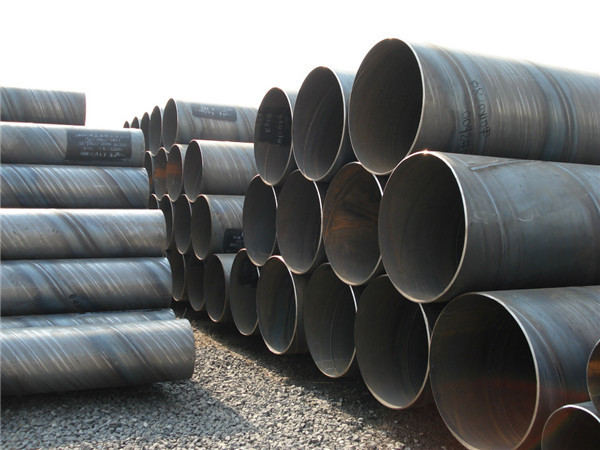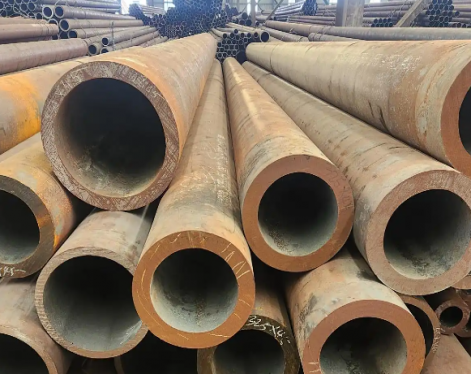SSAW steel pipe is a welded steel tube made of strip steel coil as raw material, extruded at regular temperature, and welded by automatic double-wire double-sided submerged arc welding process.After the SSAW steel pipes are transported to the site, the pipes are first arranged according to the location of the equipment and pipe fittings, and the specific length of each steel pipe is measured on site, and the specific size and arrangement position are marked. In order to be seated according to the number at the interface, a crane is used to lower the pipe, and nylon slings are used for hoisting during the lowering process to protect the pipe insulation layer.
1. Repair the mouth, match the mouth
The trimming is concentrated on the processing of SSAW steel pipes before leaving the factory. In order to ensure the welding quality, a comprehensive inspection and correction are carried out before welding, so that the pipe end face, bevel angle, blunt edge, roundness, etc., all meet the requirements of the size of the counterpart joint. When some steel pipes need to be grooved on site, they are cut by gas welding, and the slag is removed, and then they are polished with grinding wheels.
The counterpart operation procedure is: check the size of the interface joint → clear the chamber → determine and adjust the staggered position of the longitudinal weld seam of the steel pipe → straighten the pipe for the first time → adjust the gap size of the counterpart → level the counterpart → straighten the pipe pull line → spot welding

2.Installation welding
Arc welding is used for interface welding, one pass for priming and two passes for survival, each weld seam is welded once, and the arc ignition and extinguishing points for each layer of welding must be staggered.
1) Before welding the pipe joints, the mouth should be repaired, the slag should be cleaned, the bevel angle, blunt edge, and gap of the pipe end face should meet the specifications; it is not allowed to clamp welding strips in the gap between the counterparts or use heating to reduce the gap for welding.
2) When aligning, the inner wall should be flush, and a ruler with a length of 300mm should be used to sequentially stick around the inner wall of the interface. The allowable deviation of the misalignment should be 0.2 times the wall thickness, and should not be greater than 2mm.
3) The position of the counter longitudinal and circumferential welds shall meet the following requirements:
a. The longitudinal weld should be at about 45° of the semicircle on the vertical line of the center of the pipeline;
b. For reinforced SSAW steel pipes, the butt weld of the reinforcement ring shall be staggered from the longitudinal weld of the pipe joint, and the distance shall not be less than 100mm; the distance between the reinforcement ring and the circumferential weld of the pipe joint shall not be less than 50mm;
c. There shall be no cross-shaped welds at any position of SSAW steel pipes.
4) During tack welding, the numbers (or grades) of all electrodes for tack welding should be the same as those for formal welding, but the diameter of the electrodes can be thinner. The welding current of the tack welding seam should be selected larger than that of the formal welding, usually 10%-15% larger, to ensure penetration.
5) Welding of SSAW steel pipe: the weld seam should be smooth, the width should be consistent, and the root should be penetrated. There are no obvious concave-convex defects and undercuts. The reinforced surface of the weld seam should be about 2 mm higher than the pipe surface, and the edge of the welded groove should be 2-3 mm.
6) When the pipe and the flange are welded, the pipe should be inserted into the flange by two-thirds, the flange and the pipe should be perpendicular, and the axes of the two coincide.
a. The slope of the horizontal pipeline is not less than 0.3%.
b. Check the welding environment before welding, the drying and cleaning of welding installation equipment and welding materials must comply with the specifications and welding operation regulations.
c. The back of the root of the weld should be cleaned and inspected. After cleaning the defects, the back weld can be welded. It is stipulated that the weld seam for root cleaning shall be welded after visual inspection after root cleaning.
d. Pipelines with a pipe wall greater than 4mm must be grooved before welding, and the surface of the groove must not have defects such as interlayers, cracks, processing damage, burrs, and flame cutting slag. After welding, the drug skin should be knocked clean, and the welding joint should be in the shape of uniform fish scales. There should be no pores, slag inclusions, cracks, welding tumors, etc., and the length of the biting meat should be within the specification requirements.
7) The deflation valve larger than 20mm adopts flange connection, and the deflation valve less than or equal to 20mm adopts threaded connection.
8) There should be no joints and welds where the pipe turns, passes through the wall, and supports and hangers. When the pipe passes through the wall, a casing should be embedded, and the diameter of the casing should be 50mm larger than the outer diameter of the pipe insulation. The highest point of the pipeline is provided with an air release valve, and the lowest point is provided with a water release valve.
1. Repair the mouth, match the mouth
The trimming is concentrated on the processing of SSAW steel pipes before leaving the factory. In order to ensure the welding quality, a comprehensive inspection and correction are carried out before welding, so that the pipe end face, bevel angle, blunt edge, roundness, etc., all meet the requirements of the size of the counterpart joint. When some steel pipes need to be grooved on site, they are cut by gas welding, and the slag is removed, and then they are polished with grinding wheels.
The counterpart operation procedure is: check the size of the interface joint → clear the chamber → determine and adjust the staggered position of the longitudinal weld seam of the steel pipe → straighten the pipe for the first time → adjust the gap size of the counterpart → level the counterpart → straighten the pipe pull line → spot welding

2.Installation welding
Arc welding is used for interface welding, one pass for priming and two passes for survival, each weld seam is welded once, and the arc ignition and extinguishing points for each layer of welding must be staggered.
1) Before welding the pipe joints, the mouth should be repaired, the slag should be cleaned, the bevel angle, blunt edge, and gap of the pipe end face should meet the specifications; it is not allowed to clamp welding strips in the gap between the counterparts or use heating to reduce the gap for welding.
2) When aligning, the inner wall should be flush, and a ruler with a length of 300mm should be used to sequentially stick around the inner wall of the interface. The allowable deviation of the misalignment should be 0.2 times the wall thickness, and should not be greater than 2mm.
3) The position of the counter longitudinal and circumferential welds shall meet the following requirements:
a. The longitudinal weld should be at about 45° of the semicircle on the vertical line of the center of the pipeline;
b. For reinforced SSAW steel pipes, the butt weld of the reinforcement ring shall be staggered from the longitudinal weld of the pipe joint, and the distance shall not be less than 100mm; the distance between the reinforcement ring and the circumferential weld of the pipe joint shall not be less than 50mm;
c. There shall be no cross-shaped welds at any position of SSAW steel pipes.
4) During tack welding, the numbers (or grades) of all electrodes for tack welding should be the same as those for formal welding, but the diameter of the electrodes can be thinner. The welding current of the tack welding seam should be selected larger than that of the formal welding, usually 10%-15% larger, to ensure penetration.
5) Welding of SSAW steel pipe: the weld seam should be smooth, the width should be consistent, and the root should be penetrated. There are no obvious concave-convex defects and undercuts. The reinforced surface of the weld seam should be about 2 mm higher than the pipe surface, and the edge of the welded groove should be 2-3 mm.
6) When the pipe and the flange are welded, the pipe should be inserted into the flange by two-thirds, the flange and the pipe should be perpendicular, and the axes of the two coincide.
a. The slope of the horizontal pipeline is not less than 0.3%.
b. Check the welding environment before welding, the drying and cleaning of welding installation equipment and welding materials must comply with the specifications and welding operation regulations.
c. The back of the root of the weld should be cleaned and inspected. After cleaning the defects, the back weld can be welded. It is stipulated that the weld seam for root cleaning shall be welded after visual inspection after root cleaning.
d. Pipelines with a pipe wall greater than 4mm must be grooved before welding, and the surface of the groove must not have defects such as interlayers, cracks, processing damage, burrs, and flame cutting slag. After welding, the drug skin should be knocked clean, and the welding joint should be in the shape of uniform fish scales. There should be no pores, slag inclusions, cracks, welding tumors, etc., and the length of the biting meat should be within the specification requirements.
7) The deflation valve larger than 20mm adopts flange connection, and the deflation valve less than or equal to 20mm adopts threaded connection.
8) There should be no joints and welds where the pipe turns, passes through the wall, and supports and hangers. When the pipe passes through the wall, a casing should be embedded, and the diameter of the casing should be 50mm larger than the outer diameter of the pipe insulation. The highest point of the pipeline is provided with an air release valve, and the lowest point is provided with a water release valve.









